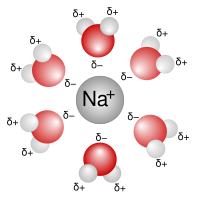
Photo from wikipedia
Abstract A concrete understanding of hydrate dissociation behavior is crucial for hydrate exploration and oil/gas transportation. A microfluidic chip has been used in this study to visualize cyclopentane (CP) hydrate… Click to show full abstract
Abstract A concrete understanding of hydrate dissociation behavior is crucial for hydrate exploration and oil/gas transportation. A microfluidic chip has been used in this study to visualize cyclopentane (CP) hydrate dissociation. The results showed that during CP-pure water hydrate dissociation, the guest fluid (CP) released from the CP hydrate behaves like small CP microdroplets, forming a stable CP-in-water emulsion. The size and size distribution of the released CP microdroplets are quantified. The mean size of the microdroplets was around 5.3 μm, while the size distribution was within a narrow range of 4 to 9 μm. Fewer and less stable CP microdroplets were released from the CP-brine hydrate dissociation, while more significant coalescences of the CP microdroplets were observed at a higher salt concentration. For the CP-SDS system, a thick and stable emulsion layer was formed by the mass of tiny CP microdroplets released from the CP hydrate during hydrate dissociation.
Journal Title: Chemical Engineering Science
Year Published: 2020
Link to full text (if available)
Share on Social Media: Sign Up to like & get
recommendations!